« Prev Next »

Each Organism's Traits Are Inherited from a Parent through Transmission of DNA
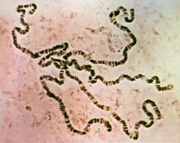
What is a gene?
Physically, a gene is a segment (or segments) of a chromosome. Functionally, a gene can play many different roles within a cell. Today, most scientists agree that genes correspond to one or more DNA sequences that carry the coding information required to produce a specific protein, and that protein in turn carries out a particular function within the cell. Scientists also know that the DNA that makes up genes is packed into structures called chromosomes, and that somatic cells contain twice as many chromosomes as gametes (i.e., sperm and egg cells).
But what were the key scientific discoveries that helped establish these principles? As it turns out, the connections between genes, chromosomes, DNA, and heredity were not recognized until long after researchers caught their initial glimpse of chromosomes. The following sections present an abbreviated summary of the major discoveries that revealed these connections.
The first words for genes: Elementen and gemmules
Researchers began hypothesizing about the existence of genes as early as the mid-1800s — although they used different terminology than today's scientists when doing so. For example, during the 1860s, Austrian monk and scientist Gregor Mendel (Figure 1) examined how certain physical characteristics of pea plants (e.g., seed color, seed shape, flower color, etc.), which he called traits, were passed down to successive generations. Mendel speculated that the cells that made up the pea plants contained material that carried the information about these traits from one generation to the next. Mendel called this material "elementen," and he proposed that during sexual reproduction, each parent contributed a form of elementen to the resulting offspring. This combination of parental elementen then determined which form of a trait was visible in the offspring.
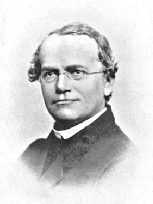

After Mendel and Darwin put their ideas forward, several other scientists reported their own discoveries about the ways in which the appearance of the cellular nucleus changed during cell division. Although these scientists' observations connected genes to chromosomes, they still didn't use the word "gene" to represent what Mendel called "elementen" or what Darwin called "gemmules." The concept of the "chromosome," however, was rapidly becoming much clearer.
Describing chromosomes

Connecting heredity to chromosomes
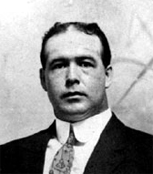
Scientists now knew how chromosomes behaved during both mitosis and meiosis, but they still hadn't linked Mendel's ideas of heredity with these observations.
Some thirty-five years after Mendel's work, however, American researcher Walter Sutton (Figure 4) proposed a connection between trait inheritance and the path that chromosomes travel during meiotic cell division and gamete formation. In particular, when observing meiotic cells in the testes of the lubber grasshopper (Brachystola magna), Sutton noted that it was possible to distinguish and track the individual chromosomes in these cells. He also noticed that these chromosomes existed in pairs that could be distinguished from other pairs by their size, and that upon the union of two gametes during fertilization, the chromosomes in the newly fertilized cell maintained their original forms. Sutton therefore proposed that all chromosomes have a stable structure, or "individuality," that is maintained between generations. Bringing the idea full circle, Sutton also concluded that the association of paternal and maternal chromosomes in pairs after gamete fusion, and their subsequent separation during the reducing division of meiosis, "may constitute the physical basis of the Mendelian law of heredity." With these words, Sutton first articulated what is now known as the chromosome theory of inheritance.
Confirming the chromosome theory of inheritance
Though Sutton believed he had described evidence for the physical basis of Mendel's principles of inheritance, definitive proof was still lacking. Scientists thus needed an experimental system in which the inheritance of genetic traits could be linked directly to the movement of chromosomes. Such an opportunity presented itself soon thereafter, with a distinct mutation in the fruit fly Drosophila melanogaster.
During the early years of the twentieth century, fruit flies were the model organism of choice for many genetic researchers, including those who worked in Thomas Hunt Morgan's famous "fly room" laboratory at Columbia University in New York City. Why fruit flies? For one, fruit flies breed quickly, so they are efficient organisms for scientists who want to follow traits in offspring through several generations. Also, the fruit fly has only four pairs of chromosomes, so these chromosomes can be easily recognized and tracked from one generation to the next. The Morgan lab therefore set out to examine patterns of heredity through multiple series of breeding experiments with fruit flies, and in doing so, they hoped to discover exactly how heredity was or was not related to chromosomes. Eventually, the answer to this question became clear-all because of the appearance of a lone fly with unusually colored eyes.
Morgan's lab connects eye color with inheritance of sex chromosomes
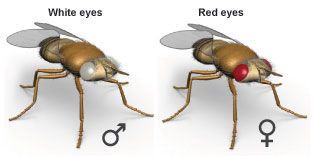
Fruit flies normally have brilliant, red-colored eyes, although occasionally, male flies with white eyes would appear in Morgan's laboratory (Figure 5). Intrigued by these white-eyed males, Morgan's research team decided to follow this trait through multiple breeding cycles of white eyed males and red-eyed females. In doing so, the researchers noticed that the white-eyed trait was only passed onto other male flies. In fact, after the researchers conducted multiple rounds of breeding white-eyed males and red-eyed females without identifying a single white-eyed female, they began to suspect that white eye color was inherited along with the sex of the fly.
This observation confirmed the chromosome theory proposed by Sutton. According to this theory, male flies should always inherit male characteristics by virtue of inheriting the "male" chromosome (denoted Y); likewise, female flies should always inherit "female" chromosomes (denoted X), which means that these flies should not display male characteristics. Thousands of matings had convinced the Morgan lab that white eyes were clearly a characteristic associated with only the Y chromosome.
One day, however, the researchers in Morgan's lab encountered an unusual fly that challenged their conclusions regarding the relationship between sex and eye color. This exceptional fly was a white-eyed female that had resulted from a cross between two parents with red eyes. Where did this female's white-eye trait come from? How could this trait be explained? And did this fly disprove the basic premise of the chromosome theory?
The exception proves the rule
In the Morgan lab's search to make sense of the white-eyed female, Lilian Vaughn Morgan (Thomas Morgan's wife) suggested that this exceptional fly might have an unusual chromosome composition. The research team seized upon this suggestion, and they soon examined some of the white-eyed female's cells under the microscope. In doing so, the scientists realized that Mrs. Morgan was right - the fly's cells did indeed appear to contain an extra chromosome. Specifically, these cells contained two X chromosomes as well as a single Y chromosome. The extra chromosome was determined to be the result of a defect during meiosis that caused a high frequency of nondisjunction. (Nondisjunction is the failure of two sister chromatids to separate during the second meiotic division.) Thus, when an egg containing two nondisjoined X chromosomes, each of which carried the mutant white gene, was fertilized by a sperm cell containing the Y chromosome, the product was an XXY female with white eyes. Rather than disproving the chromosome theory, this "exceptional" female actually provided strong experimental support that genes were in fact located on chromosomes.
The Morgan lab's observations can be simplified as follows:
• First observation: Flies normally have red eyes.
• Second observation: Males sometimes have white eyes.
• Third observation: Females never have white eyes.
• Fourth observation, exception to the rule: A rare female has white eyes, and she also has an extra chromosome.
• Conclusion: Traits are found on chromosomes.
Morgan's lab also found that the trait for white eyes could appear even if a fly's father didn't have white eyes. This showed that flies could carry the white-eye trait even if they didn't show it themselves. The trait could vanish and reappear only in certain exceptional moments. This concept forms the basis of our modern understanding of the hereditary substance that exists on chromosomes but is not always apparent in the outward physical traits of an organism. Whereas Mendel called this substance "elementen" and Darwin called it "gemmules," researchers now use the more familiar term "gene."
Summary
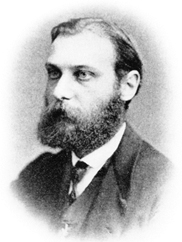
When considered in view of all this information, the chromosome theory of inheritance was not the work of a single scientist. Rather, the theory was built on collaboration between multiple researchers working over a period of many decades. The seeds of this theory were first planted in the 1860s, when Gregor Mendel and Charles Darwin each proposed possible physical elements of heredity. It wasn't until several decades later, following Walther Flemming's (Figure 6) discovery of chromosomes and description of their behavior during mitosis, that a probable mechanism for the transmission of traits was uncovered.
Subsequently, Theodor Boveri and Walter Sutton's research strengthened the idea of a connection between chromosomes and hereditary elements. But direct evidence that explicitly demonstrated that traits exist on specific chromosomes wasn't delivered until the Morgan lab's experiments with fruit flies at the beginning of the twentieth century. Thus, after nearly fifty years of speculation, scientists were finally able to confirm what they had long suspected: chromosomes are indeed the physical carriers of hereditary information, and this information exists in the form of genes.
Further Exploration
Key Questions
eBooks
This page appears in the following eBook





















